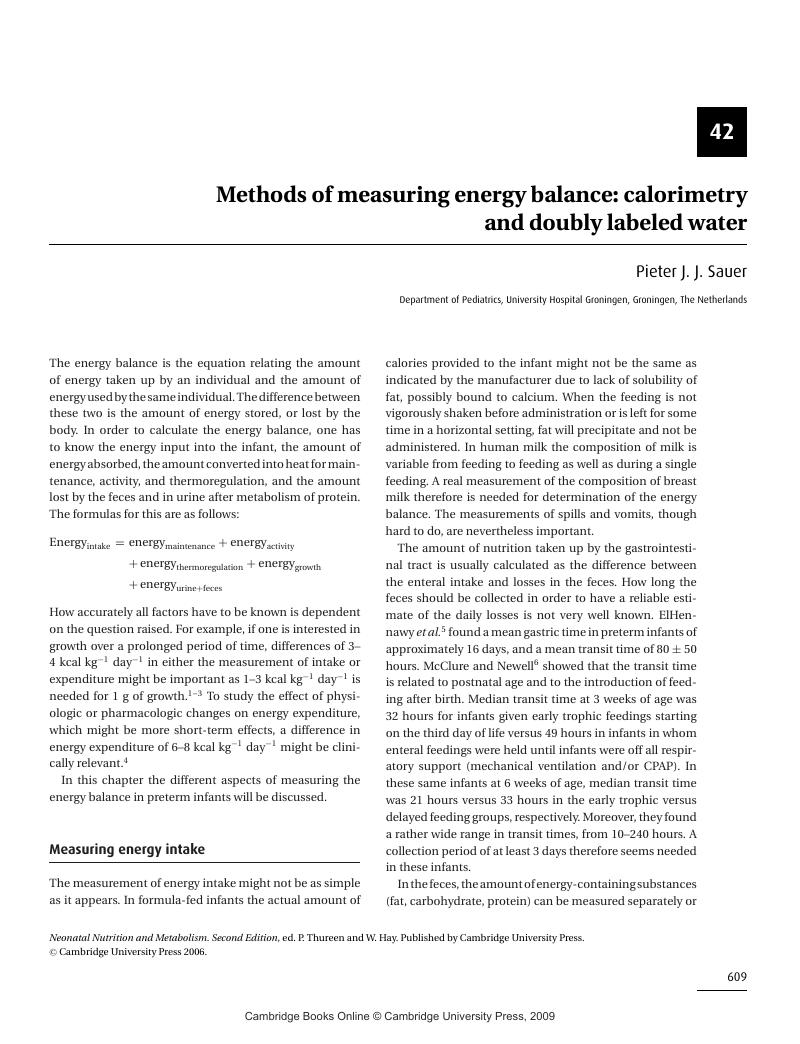Book contents
- Frontmatter
- Contents
- List of contributors
- Preface
- Acknowledgments
- List of abbreviations
- 1 Fetal nutrition
- 2 Determinants of intrauterine growth
- 3 Aspects of fetoplacental nutrition in intrauterine growth restriction and macrosomia
- 4 Postnatal growth in preterm infants
- 5 Thermal regulation and effects on nutrient substrate metabolism
- 6 Development and physiology of the gastrointestinal tract
- 7 Metabolic programming as a consequence of the nutritional environment during fetal and the immediate postnatal periods
- 8 Nutrient regulation in brain development: glucose and alternate fuels
- 9 Water and electrolyte balance in newborn infants
- 10 Amino acid metabolism and protein accretion
- 11 Carbohydrate metabolism and glycogen accretion
- 12 Energy requirements and protein-energy metabolism and balance in preterm and term infants
- 13 The role of essential fatty acids in development
- 14 Vitamins
- 15 Normal bone and mineral physiology and metabolism
- 16 Disorders of mineral, vitamin D and bone homeostasis
- 17 Trace minerals
- 18 Iron
- 19 Conditionally essential nutrients: choline, inositol, taurine, arginine, glutamine and nucleotides
- 20 Intravenous feeding
- 21 Enteral amino acid and protein digestion, absorption, and metabolism
- 22 Enteral carbohydrate assimilation
- 23 Enteral lipid digestion and absorption
- 24 Minimal enteral nutrition
- 25 Milk secretion and composition
- 26 Rationale for breastfeeding
- 27 Fortified human milk for premature infants
- 28 Formulas for preterm and term infants
- 29 Differences between metabolism and feeding of preterm and term infants
- 30 Gastrointestinal reflux
- 31 Hypo- and hyperglycemia and other carbohydrate metabolism disorders
- 32 The infant of the diabetic mother
- 33 Neonatal necrotizing enterocolitis: clinical observations and pathophysiology
- 34 Neonatal short bowel syndrome
- 35 Acute respiratory failure
- 36 Nutrition for premature infants with bronchopulmonary dysplasia
- 37 Nutrition in infants with congenital heart disease
- 38 Nutrition therapies for inborn errors of metabolism
- 39 Nutrition in the neonatal surgical patient
- 40 Nutritional assessment of the neonate
- 41 Methods of measuring body composition
- 42 Methods of measuring energy balance: calorimetry and doubly labelled water
- 43 Methods of measuring nutrient substrate utilization using stable isotopes
- 44 Postnatal nutritional influences on subsequent health
- 45 Growth outcomes of preterm and very low birth weight infants
- 46 Post-hospital nutrition of the preterm infant
- Index
- References
42 - Methods of measuring energy balance: calorimetry and doubly labelled water
Published online by Cambridge University Press: 10 December 2009
- Frontmatter
- Contents
- List of contributors
- Preface
- Acknowledgments
- List of abbreviations
- 1 Fetal nutrition
- 2 Determinants of intrauterine growth
- 3 Aspects of fetoplacental nutrition in intrauterine growth restriction and macrosomia
- 4 Postnatal growth in preterm infants
- 5 Thermal regulation and effects on nutrient substrate metabolism
- 6 Development and physiology of the gastrointestinal tract
- 7 Metabolic programming as a consequence of the nutritional environment during fetal and the immediate postnatal periods
- 8 Nutrient regulation in brain development: glucose and alternate fuels
- 9 Water and electrolyte balance in newborn infants
- 10 Amino acid metabolism and protein accretion
- 11 Carbohydrate metabolism and glycogen accretion
- 12 Energy requirements and protein-energy metabolism and balance in preterm and term infants
- 13 The role of essential fatty acids in development
- 14 Vitamins
- 15 Normal bone and mineral physiology and metabolism
- 16 Disorders of mineral, vitamin D and bone homeostasis
- 17 Trace minerals
- 18 Iron
- 19 Conditionally essential nutrients: choline, inositol, taurine, arginine, glutamine and nucleotides
- 20 Intravenous feeding
- 21 Enteral amino acid and protein digestion, absorption, and metabolism
- 22 Enteral carbohydrate assimilation
- 23 Enteral lipid digestion and absorption
- 24 Minimal enteral nutrition
- 25 Milk secretion and composition
- 26 Rationale for breastfeeding
- 27 Fortified human milk for premature infants
- 28 Formulas for preterm and term infants
- 29 Differences between metabolism and feeding of preterm and term infants
- 30 Gastrointestinal reflux
- 31 Hypo- and hyperglycemia and other carbohydrate metabolism disorders
- 32 The infant of the diabetic mother
- 33 Neonatal necrotizing enterocolitis: clinical observations and pathophysiology
- 34 Neonatal short bowel syndrome
- 35 Acute respiratory failure
- 36 Nutrition for premature infants with bronchopulmonary dysplasia
- 37 Nutrition in infants with congenital heart disease
- 38 Nutrition therapies for inborn errors of metabolism
- 39 Nutrition in the neonatal surgical patient
- 40 Nutritional assessment of the neonate
- 41 Methods of measuring body composition
- 42 Methods of measuring energy balance: calorimetry and doubly labelled water
- 43 Methods of measuring nutrient substrate utilization using stable isotopes
- 44 Postnatal nutritional influences on subsequent health
- 45 Growth outcomes of preterm and very low birth weight infants
- 46 Post-hospital nutrition of the preterm infant
- Index
- References
Summary

- Type
- Chapter
- Information
- Neonatal Nutrition and Metabolism , pp. 609 - 616Publisher: Cambridge University PressPrint publication year: 2006



